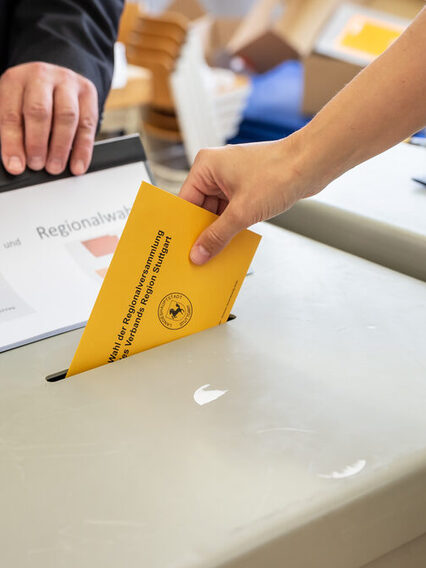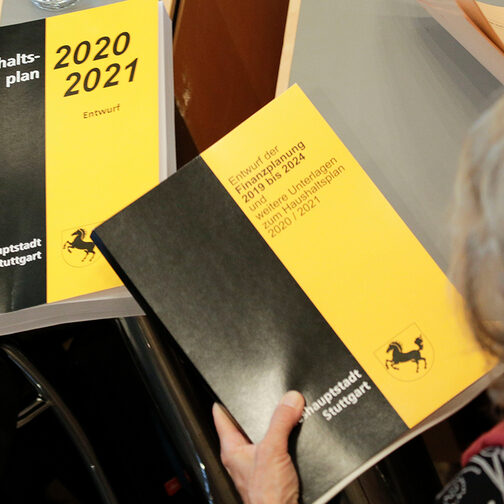An dieser Stelle finden Sie eine kleine Auswahl an Statistiken. Sie zeigen die demografische, soziale, ökonomische und ökologische Situation in Stuttgart. Weitere Daten finden Sie auf folgenden Online‐Angeboten:
Auswahl an Statistiken
Einwohner
In der Landeshauptstadt leben mehr als 600.000 Einwohnerinnen und Einwohner. Stuttgart ist eine junge Stadt mit einem Durchschnittsalter von etwas über 42 Jahren. Der Anteil der Menschen mit Migrationshintergrund liegt in der internationalen Stadtgesellschaft bei etwa 48 Prozent.
Die kommunalen Bevölkerungszahlen stammen aus dem Stuttgarter Einwohnermelderegister. Sie ermöglichen kleinräumige Analysen etwa zur Zusammensetzung der Bevölkerung nach Alter, Nationalität und Familienstand sowie zur natürlichen Bevölkerungsentwicklung und Wanderungsentwicklung. Daher verwendet die Landeshauptstadt die kommunalen Zahlen als maßgebliche Einwohnerzahl für Stuttgart. Für Vergleiche mit anderen Gemeinden sollte in der Regel auf die amtlichen Bevölkerungszahlen der Statistischen Landesämter zurückgegriffen werden.
Aktuelle Informationen zur Einwohnerentwicklung (Öffnet in einem neuen Tab)
Aktuelle Einwohnerzahlen nach Stadtbezirken und Stadtteilen (Öffnet in einem neuen Tab)
Einwohner nach Staatsangehörigkeit und Geschlecht (Öffnet in einem neuen Tab)
Einwohner nach Altersgruppen (Öffnet in einem neuen Tab)
Einwohner nach Migrationshintergrund (Öffnet in einem neuen Tab)
Einwohnerbilanz (Öffnet in einem neuen Tab)
Wanderungssaldo für ausgewählte Gebiete (Öffnet in einem neuen Tab)
Haushalte nach Personenzahl (xlsx) (Öffnet in einem neuen Tab)
Haushalte nach Kinderzahl (xlsx) (Öffnet in einem neuen Tab)
Faltblatt Stuttgarter Bevölkerungsdaten (PDF) (Öffnet in einem neuen Tab)
Faltblatt Stuttgarter Familiendaten (PDF) (Öffnet in einem neuen Tab)
Weitere Informationen zur Einwohner‐ und Haushaltestruktur sowie zu Bevölkerungsbewegungen finden Sie im KOMUNIS (Öffnet in einem neuen Tab), im Statistikatlas (Öffnet in einem neuen Tab) und im Sozialmonitoring (Öffnet in einem neuen Tab).
Stadtgebiet und Klima
Charakteristisch für Stuttgart ist seine ausgeprägte Topografie. Der höchste Punkt des Stadtgebiets liegt auf 549 Metern Höhe, der niedrigste auf 207 Metern. Ebenso typisch sind die vielen Grün‐ und Freiflächen. Insgesamt besteht fast die Hälfte der Stadtfläche aus Wäldern, Äckern und Parks. Klimatisch liegt Stuttgart innerhalb der gemäßigten Zone mit warmen Sommern und kalten Wintern. Dabei sorgen die umliegenden Höhenrücken wie der Schwarzwald für moderate Regenfälle.
Flächennutzung (XLSX) (Öffnet in einem neuen Tab)
Geografische Daten (XLSX) (Öffnet in einem neuen Tab)
Temperaturen (XLSX) (Öffnet in einem neuen Tab)
Niederschläge (XLSX) (Öffnet in einem neuen Tab)
Religion
Stuttgart hat sich von einer evangelischen Stadt zu einer Stadt der religiösen Vielfalt entwickelt. Rund 250 Gemeinden, Kirchen und Glaubensgemeinschaften prägen die religiöse Landschaft der Stadt. Dabei sind heute weniger als die Hälfte der Einwohnerinnen Einwohner Mitglied in der evangelischen oder römisch‐katholischen Kirche. Rund zehn Prozent der Stuttgarterinnen und Stuttgarter sind muslimischen Glaubens, ein Viertel bezeichnet sich als nicht religiös.
Stuttgarter Atlas der Religionen (PDF) (Öffnet in einem neuen Tab)
Bauen und Wohnen
Ein wichtiges Anliegen der Landeshauptstadt ist es, den Bedarf an angemessenem Wohnraum zu decken. Neben dem städtischen Wohnungsbau ist der private Wohnungsbau ein wichtiger Faktor, um dieses Ziel zu erreichen. Stadt und Wohnungsbauer haben sich im „Bündnis für Wohnen“ gegenseitig verpflichtet, gemeinsam die Wohnungsbauziele vor allem im geförderten Bereich zu erreichen.
Gebäude‐ und Wohnungsbestand (xlsx) (Öffnet in einem neuen Tab)
Baufertigstellungen (xlsx) (Öffnet in einem neuen Tab)
Geförderter Wohnungsmarkt (xlsx) (Öffnet in einem neuen Tab)
Stuttgarter Wohnungsdaten (PDF) (Öffnet in einem neuen Tab)
Wohnungsmarktbericht (PDF) (Öffnet in einem neuen Tab)
Tabellen zum Wohnungsmarktbericht (xlsx) (Öffnet in einem neuen Tab)
Weitere Berichte und Tabellen zum Stuttgarter Wohnungsmarkt finden Sie im KOMUNIS (Öffnet in einem neuen Tab).
Arbeitsmarkt
Der Stuttgarter Arbeitsmarkt ist gekennzeichnet durch hohe Beschäftigung, hohe Qualifizierung, hohe Mobilität und niedrige Arbeitslosigkeit. Rund 538.000 Personen waren 2022 am Arbeitsort Stuttgart erwerbstätig, davon fast 15 Prozent im Produzierenden Gewerbe. Über 60 Prozent der in Stuttgart sozialversicherungspflichtig Beschäftigten pendelten 2023 von außerhalb zu ihrem Arbeitsplatz nach Stuttgart.
In die andere Richtung pendelten 2023 über 101.000 Beschäftigte Stuttgarter zu ihrem Arbeitsplatz außerhalb. Das ist Ausdruck der hohen Mobilität am Arbeitsmarkt. Über ein Drittel der Beschäftigten haben eine akademische Ausbildung, im Landesdurchschnitt lediglich 22 Prozent. 20.750 Arbeitslose stehen 4.630 offenen Stellen gegenüber (Stand: Dezember 2024).
Beschäftigte nach Wirtschaftsabschnitten (xlsx) (Öffnet in einem neuen Tab)
Beschäftigte nach Wohn‐ und Arbeitsort (xlsx) (Öffnet in einem neuen Tab)
Arbeitslose und gemeldete Stellen (xlsx) (Öffnet in einem neuen Tab)
Wirtschaftsleistung
Stuttgart gehört zu den bedeutendsten Wirtschaftsmetropolen in ganz Europa. Weltweit tätige Großkonzerte und mittelständische Unternehmen haben hier ihren Sitz. Innovative Unternehmen unter anderem aus dem Fahrzeug‐ und Maschinenbau haben Stuttgart weltbekannt gemacht. Über 29.000 Unternehmen haben ihren Sitz in Stuttgart, 2022 setzten diese über 308 Milliarden Euro um. Die Bruttowertschöpfung (Gesamtwert aller produzierten Waren und Dienstleistungen, abzüglich der sogenannten Vorleistungen) lag 2022 bei 53.144 Millionen Euro, das entspricht etwas mehr als 10 Prozent der Wertschöpfung des Landes Baden‐Württemberg. Ein entsprechend hohes Lohn‐ aber auch Mietpreisniveau geht damit einher.
Bruttowertschöpfung und Bruttoinlandsprodukt (xlsx) (Öffnet in einem neuen Tab)
Einkommen (xlsx) (Öffnet in einem neuen Tab)
Preisindex (xlsx) (Öffnet in einem neuen Tab)
Strom‐, Erdgas‐ und Wasserpreise (xlsx) (Öffnet in einem neuen Tab)
Soziales
Der Sozialstaat dient der finanziellen Absicherung des grundlegenden Lebensunterhalts von vorübergehend oder dauerhaft in Not geratener Personen. Die Transferleistungen der sozialen Mindestsicherung ermöglichen dabei eine menschenwürdige Lebensführung. Die Transferleistungen umfassen das Bürgergeld (früher Arbeitslosengeld II), das Sozialgeld, die Hilfe zum Lebensunterhalt, die Grundsicherung im Alter und bei Erwerbsminderung sowie Regelleistungen nach dem Asylbewerberleistungsgesetz.
Empfänger von sozialen Mindestsicherungsleistungen in Stuttgart seit 2010 (XLSX) (Öffnet in einem neuen Tab)
Mindestsicherungsquote im regionalen Vergleich seit 2010 (XLSX) (Öffnet in einem neuen Tab)
Mindestsicherungsquote in ausgewählten Großstädten seit 2010 (XLSX) (Öffnet in einem neuen Tab)
Ansprechpartner beim Statistischen Amt für den Bereich Soziales ist Fabian Schütt.
Gesundheit
Ambulante und stationäre Einrichtungen bilden die Eckpfeiler der Gesundheitsversorgung. Niedergelassene Ärzte, Krankenhäuser und Rehabilitationseinrichtungen kümmern sich nicht nur um Patientinnen und Patienten aus Stuttgart. Menschen aus der ganzen Region und weit darüber hinaus finden auf der Suche nach medizinischer Hilfe Ansprechpartner in unserer Stadt. Hinzu kommen stationäre Pflegeeinrichtungen und ambulant tätige Pflegedienste. Auch diese übernehmen in der Gesundheitsversorgung eine wichtige Funktion.
Schwerbehinderte Menschen in Stuttgart seit 1999 (XLSX) (Öffnet in einem neuen Tab)
Pflegebedürftige Leistungsempfänger in Stuttgart seit 1999 (XLSX) (Öffnet in einem neuen Tab)
Krankenhäuser und Betten nach Träger in Stuttgart seit 2009 (XLSX) (Öffnet in einem neuen Tab)
Ärzte in freier Praxis in Stuttgart seit 2008 (XLSX) (Öffnet in einem neuen Tab)
Kennzahlen der Pflege im regionalen Vergleich (XLSX) (Öffnet in einem neuen Tab)
Kennzahlen der Pflege in ausgewählten Großstädten (XLSX) (Öffnet in einem neuen Tab)
Bildung
Stuttgart ist mit über 94.000 Schülern (Schuljahr 2023/2024) und annähernd 58.000 Studierenden (Wintersemester 2022/2023) der bedeutendste Bildungsstandort in Baden‐Württemberg. Das Spektrum reicht von der Grundschule über weiterführende Schulen bis zu Fachhochschulen, Akademien und Universitäten. Auf der Grundlage der Daten des Statistischen Landesamts und des Stuttgarter Schulverwaltungsamts stellt das Statistische Amt Tabellen zu Einrichtungen, Klassen und Schülerzahlen für die Gesamtstadt und nach Stadtbezirken bereit.
Schüler in Stuttgart (XLSX) (Öffnet in einem neuen Tab)
Studierende in Stuttgart (XLSX) (Öffnet in einem neuen Tab)
Schulübergänge auf weiterführende Schulen (XLSX) (Öffnet in einem neuen Tab)
Weitere Tabellen zum Thema Schüler‐ und Studierendenzahlen und Bildungseinrichtungen finden Sie im KOMUNIS (Öffnet in einem neuen Tab).
Kriminalität
Die polizeiliche Kriminalstatistik umfasst alle der Polizei bekannt gewordenen Vorgänge, die den Verdacht eines Vergehens oder Verbrechens rechtfertigen, einschließlich der mit Strafe bedrohten Versuche. Nicht enthalten sind Ordnungswidrigkeiten, Staatsschutz‐ und Verkehrsdelikte sowie Straftaten, die außerhalb der Bundesrepublik Deutschland begangen wurden. Im Großstadtvergleich gehört Stuttgart zu den sichersten Städten.
Erfasste Straftaten und Tatverdächtige im regionalen Vergleich (XLSX) (Öffnet in einem neuen Tab)
Erfasste Straftaten und Tatverdächtige in ausgewählten Großstädten (XLSX) (Öffnet in einem neuen Tab)
Erfasste Straftaten und Tatverdächtige in Stuttgart seit 1997 (XLSX) (Öffnet in einem neuen Tab)
Kultur
Stuttgarts Kultureinrichtungen sind weit über die Stadtgrenzen hinaus bekannt: Allein das Staatstheater Stuttgart mit seinen Sparten Oper, Ballett und Schauspiel locken jährlich rund 400.000 Besucherinnen und Besucher. Hinzu kommt eine vielfältige Theater‐ und Orchesterlandschaft. Stuttgart verfügt zudem über eine vielfältige Museumslandschaft: Von technisch‐naturwissenschaftlich über Kunst und Geschichte/Archäologie bis hin zu Regional‐ und Heimatmuseen ist für jeden etwas dabei. 2023 verzeichneten die Stuttgarter Museen mit rund 3,2 Millionen Museumsgästen einen neuen Besucherrekord. Auch der Zoo Wilhelma, das Planetarium und der Fernsehturm sind beliebte Ausflugsziele deren Besuchszahlen vom Statistischen Amt erfasst werden.
Museen (XLSX) (Öffnet in einem neuen Tab)
Weitere Informationen zum Thema Kultur finden Sie im KOMUNIS (Öffnet in einem neuen Tab).
Tourismus
Die Landeshauptstadt ist sowohl bei Geschäftsreisenden als auch Touristen beliebt. Dies zeigt sich unter anderem daran, dass die Gästeankünfte und Übernachtungen seit Jahren kontinuierlich – mit wenigen Jahren Unterbrechung auf Grund der Corona‐Pandemie – gestiegen sind. So wurden 2023 in den knapp 170 geöffneten Übernachtungsbetrieben der Stadt wieder über 4 Millionen Übernachtungen verzeichnet. Die bisher erhobenen Zahlen für 2024 lassen dank der Fußball‐EM einen neuen Rekord erwarten. Inzwischen übernachten doppelt so viele Gäste in Stuttgart wie noch Ende der 1990er Jahre. Auf Grundlage der amtlichen Tourismusstatistik stellt das Statistische Amt Daten und Analysen zu Gästeankünften und Übernachtungen für die Gesamtstadt und ihre Teilbereiche bereit.
Monatliche Informationen zur Tourismusentwicklung (PDF) (Öffnet in einem neuen Tab)
Vornamen
Die Wahl des Vornamens ist eine der ersten und wichtigsten Entscheidungen, die Eltern für ihr Kind treffen – ein Name, der es ein Leben lang begleiten wird. In Stuttgart lebten Ende 2024 etwas mehr als 5.000 Kinder, die im vorherigen Jahr geboren wurden. Bei den Mädchen war Emma weiterhin der beliebteste Vorname, gefolgt von Lina, Matilda, Mia und Clara. Auch bei den Jungen blieben Noah und Karl an der Spitze, während Matteo, Paul und Theo im Ranking weiter aufstiegen.
Insgesamt gibt es in Stuttgart rund 40.000 verschiedene Vornamen. Am häufigsten vertreten sind Maria und Anna bei den Frauen sowie Michael und Thomas bei den Männern. Während Michael und Thomas besonders bei den 35- bis 50-Jährigen verbreitet sind und der Name Maria mit zunehmendem Alter häufiger auftritt, bleibt Anna auch bei den jüngeren Generationen ein populärer Name.
Weitere Informationen zur Verteilung der Vornamen in der Landeshauptstadt finden Sie im Vornamen‐Dashboard für Stuttgart (Öffnet in einem neuen Tab).
Vornamen‐Dashboard für Stuttgart
Umwelt
Umweltschutz wird in Stuttgart großgeschrieben. Die Anforderungen sind vielfältig: Die Stadtverwaltung schützt Natur und Landschaft, hält Gewässer und Luft rein, trifft Maßnahmen gegen die globale Erwärmung und steuert die Mülltrennung.
Abfallaufkommen (XLSX) (Öffnet in einem neuen Tab)
Kohlendioxid‐Emissionen (XLSX) (Öffnet in einem neuen Tab)
Trinkwasserversorgung (XLSX) (Öffnet in einem neuen Tab)
Nachhaltigkeit in Stuttgart (PDF) (Öffnet in einem neuen Tab)
Verkehr
Stuttgart ist die wohl wichtigste Verkehrsdrehscheibe Baden‐Württembergs. Die Landeshauptstadt ist eingerahmt zwischen zwei Autobahnen und wird im Talkessel von mehrspurigen Bundesstraßen durchgezogen. Die besondere topographische Lage stellt die Verkehrsplaner vor keine einfachen Aufgaben. Den öffentlichen Personennahverkehr bedienen der Verkehrs‐ und Tarifverbund Stuttgart (VVS) sowie die Stuttgarter Straßenbahn AG (SSB). Stuttgart ist zudem mit seinem Hafen und seinen Flughafen an das europäische Verkehrsnetz vielseitig angeschlossen.
Der Stuttgarter Pkw‐Bestand wird vom Statistischen Amt monatlich aus dem Fahrzeugregister ausgewertet und die Entwicklung differenziert nach Antriebsarten, Emissionsklassen und Halterart veröffentlicht.
Entwicklung des Stuttgarter Pkw‐Bestandes (PDF)
(Öffnet in einem neuen Tab) Stuttgarter Verkehrsdaten (PDF) (Öffnet in einem neuen Tab)
Finanzhaushalt
Der Haushaltsplan ist die Grundlage für die Bewirtschaftung der finanziellen Mittel. Er gibt die Richtschnur vor, an die sich Gemeinderat und Verwaltung halten müssen. Im Finanzhaushalt werden alle Ein‐ und Auszahlungen des städtischen Haushaltes geplant. Er stellt dar, ob die Stadt genügend finanzielle Mittel hat, um alle notwendigen Auszahlungen tätigen zu können, oder eventuell Kreditaufnahmen notwendig sind.
Einzahlungen im Finanzhaushalt der LHS seit 2010 (XLSX) (Öffnet in einem neuen Tab)
Auszahlungen im Finanzhaushalt der LHS seit 2010 (XLSX) (Öffnet in einem neuen Tab)
Verwaltung/Bürgerservice Statistik
Anschrift & Erreichbarkeit
Anschrift
Eberhardstraße 37
70173 Stuttgart
Postanschrift
Postfach: 104336
70038 Stuttgart
Telefon
0711 21698558Anfahrt
Anschrift
Eberhardstraße 37
70173 Stuttgart


